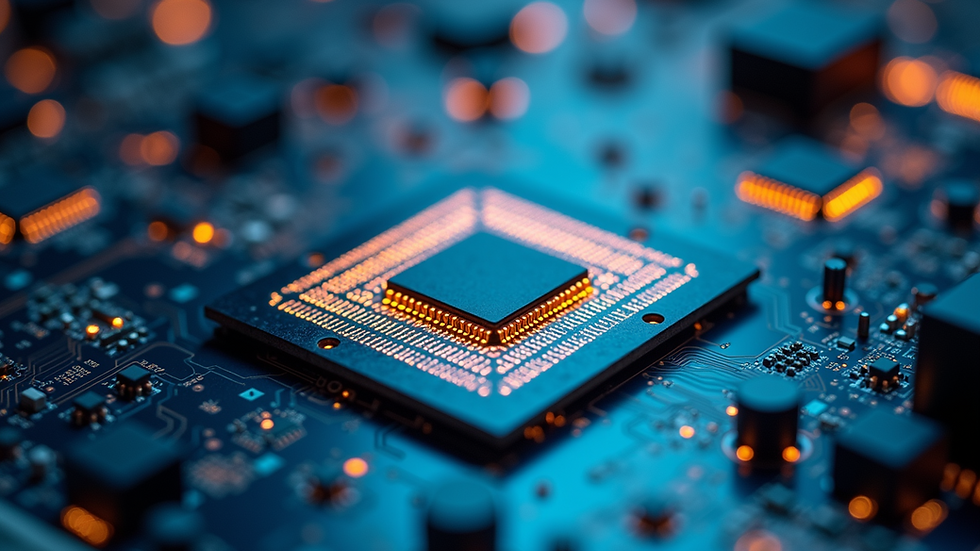VLSI: Driving Modern Electronics!
- Sanchit Kamat
- Aug 13
- 3 min read
Have you ever thought about how billions of tiny components fit into a chip smaller than your fingernail? It is fascinating technology that powers everything from smartphones to complex AI systems. This remarkable achievement comes from a process called Very Large Scale Integration, or VLSI. In this blog post, we will look closely at VLSI, its history, how chips are made, their applications, and why they are essential for our technological future.
What is VLSI?
At its core, VLSI stands for Very Large Scale Integration. It involves creating integrated circuits (ICs) by combining thousands, or even millions, of transistors into a single chip. Think of transistors as tiny switches that manage the flow of electricity, similar to traffic lights directing cars in a bustling city. The more transistors a chip can contain, the more powerful and efficient it becomes.
For example, a modern smartphone chip can contain over 10 billion transistors. This astounding number allows for seamless multitasking, efficient battery use, and advanced features like facial recognition and AI-driven photography.
VLSI technology has transformed the electronics sector, making it possible to develop compact, efficient devices that we depend on daily. From laptops to smart TVs, VLSI is the backbone of modern electronics.
A Brief History of VLSI
To grasp VLSI better, let's briefly explore its evolution. The journey began with Small Scale Integration (SSI) in the 1960s, where only a few transistors were placed on a chip. This gradually progressed to Medium Scale Integration (MSI), allowing for hundreds of transistors, then to Large Scale Integration (LSI), which paved the way for thousands of integrated transistors.
By the 1970s, we reached Very Large Scale Integration (VLSI), allowing millions of transistors on a single chip. This leap in technology laid the foundation for today’s sophisticated gadgets, making our lives simpler and more connected.
How VLSI Chips Are Made
Creating VLSI chips is a complex and meticulous process. It all starts with a silicon wafer, which acts as the chip's base. The manufacturing journey involves several critical steps:
Photolithography: This process transfers a pattern onto the wafer using light.
Etching: Unwanted material is removed to create the desired shape.
Doping: Small amounts of impurities are added to change the electrical properties of the silicon.
Picture a sculptor carefully chiseling away at a block of marble to unveil a beautiful statue. Similarly, engineers layer and etch materials to form the intricate circuitry of a VLSI chip. Once the transistors are organized, the chip undergoes thorough testing before it is packaged and distributed for use in various electronic devices.
Applications in Modern Electronics
VLSI technology is an integral part of our daily lives. Take smartphones; they rely on VLSI chips for everything from internet browsing to gaming. Computers use VLSI for rapid processing and multitasking capabilities, allowing us to work efficiently.
Additionally, VLSI is vital for the Internet of Things (IoT). Everyday items, such as smart thermostat systems and wearable fitness trackers, are interconnected to improve convenience. For instance, a recent study indicated that the number of connected IoT devices is projected to reach 30 billion by 2025. VLSI chips are at the core of these impressive innovations.
Artificial Intelligence (AI) hardware also leans on VLSI technology. The chip's ability to quickly process vast amounts of data is crucial for AI applications like natural language processing and image recognition. In fact, AI hardware performance improves by 40 percent each year, driven largely by advancements in VLSI design.
Why VLSI is Important for the Future of Technology
Looking ahead, the significance of VLSI becomes even more apparent. Technology is evolving rapidly, and the demand for smaller, faster, and more effective devices continues to rise. VLSI technology plays a critical role in addressing these demands.
As we strive for a more interconnected world, the ability of VLSI to enable IoT and AI will grow. Integrating more transistors onto smaller chips will lead to even more powerful devices that will fuel innovation across industries, from healthcare to transportation.
In a world where technology is constantly changing, VLSI stands as a foundation for progress. It not only improves the performance of existing devices but also unlocks new possibilities we have yet to explore.
Final Thoughts
VLSI is a groundbreaking technology that has reshaped the landscape of electronics. From its early days to its role as a driving force behind modern devices, VLSI shapes our digital experiences. As we look forward to the future, advancements in VLSI will undoubtedly lead to new and exciting innovations, making our lives increasingly interconnected and efficient.
Next time you admire the capabilities of your smartphone or the ease of using smart home devices, remember the tiny transistors and incredible technology of VLSI that make it all possible.




Comments